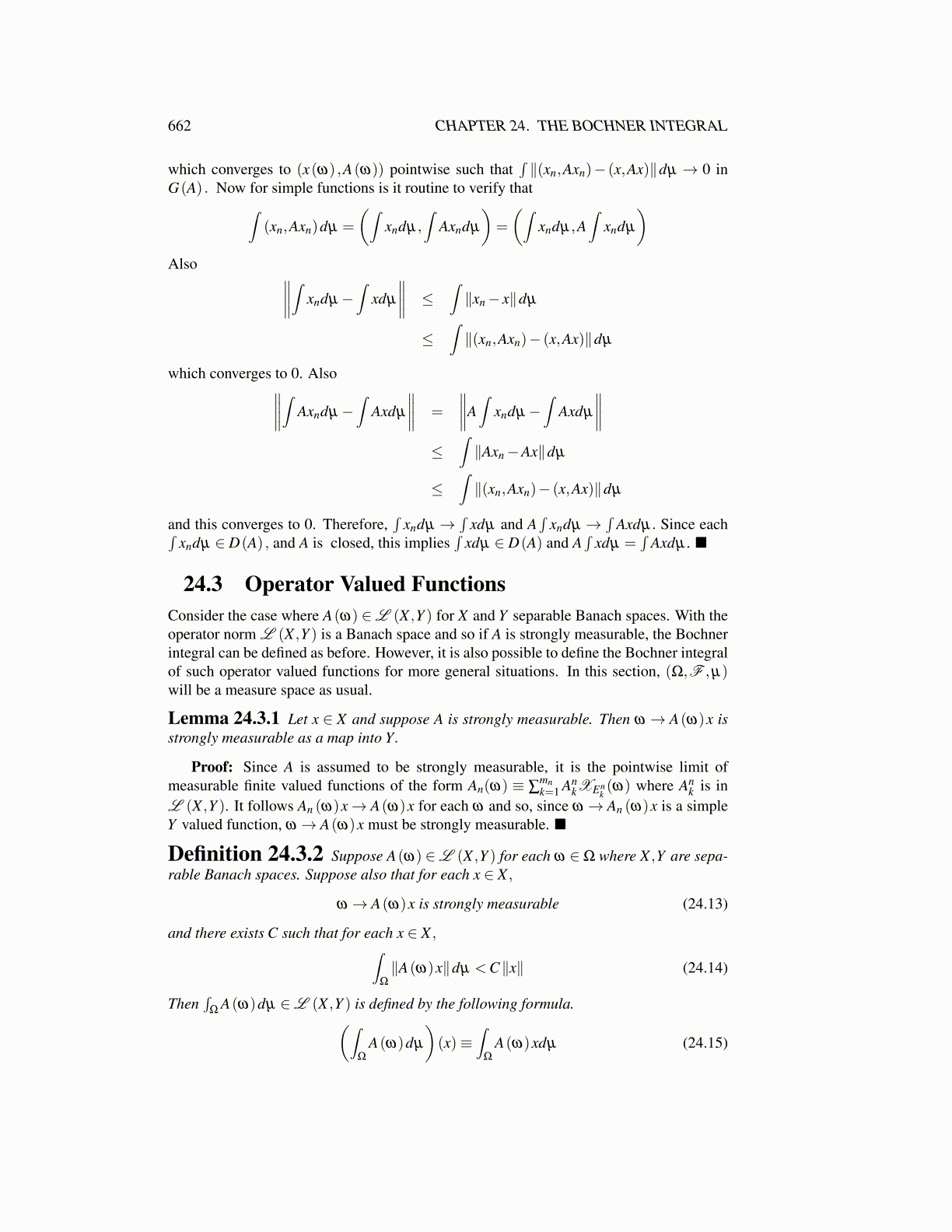
662 CHAPTER 24. THE BOCHNER INTEGRAL
which converges to (x(ω) ,A(ω)) pointwise such that∫∥(xn,Axn)− (x,Ax)∥dµ → 0 in
G(A) . Now for simple functions is it routine to verify that∫(xn,Axn)dµ =
(∫xndµ,
∫Axndµ
)=
(∫xndµ,A
∫xndµ
)Also ∥∥∥∥∫ xndµ−
∫xdµ
∥∥∥∥ ≤∫∥xn− x∥dµ
≤∫∥(xn,Axn)− (x,Ax)∥dµ
which converges to 0. Also∥∥∥∥∫ Axndµ−∫
Axdµ
∥∥∥∥ =
∥∥∥∥A∫
xndµ−∫
Axdµ
∥∥∥∥≤
∫∥Axn−Ax∥dµ
≤∫∥(xn,Axn)− (x,Ax)∥dµ
and this converges to 0. Therefore,∫
xndµ →∫
xdµ and A∫
xndµ →∫
Axdµ. Since each∫xndµ ∈ D(A) , and A is closed, this implies
∫xdµ ∈ D(A) and A
∫xdµ =
∫Axdµ . ■
24.3 Operator Valued FunctionsConsider the case where A(ω) ∈L (X ,Y ) for X and Y separable Banach spaces. With theoperator norm L (X ,Y ) is a Banach space and so if A is strongly measurable, the Bochnerintegral can be defined as before. However, it is also possible to define the Bochner integralof such operator valued functions for more general situations. In this section, (Ω,F ,µ)will be a measure space as usual.
Lemma 24.3.1 Let x ∈ X and suppose A is strongly measurable. Then ω → A(ω)x isstrongly measurable as a map into Y.
Proof: Since A is assumed to be strongly measurable, it is the pointwise limit ofmeasurable finite valued functions of the form An(ω) ≡ ∑
mnk=1 An
kXEnk(ω) where An
k is inL (X ,Y ). It follows An (ω)x→ A(ω)x for each ω and so, since ω → An (ω)x is a simpleY valued function, ω → A(ω)x must be strongly measurable. ■
Definition 24.3.2 Suppose A(ω) ∈L (X ,Y ) for each ω ∈Ω where X ,Y are sepa-rable Banach spaces. Suppose also that for each x ∈ X ,
ω → A(ω)x is strongly measurable (24.13)
and there exists C such that for each x ∈ X ,∫Ω
∥A(ω)x∥dµ <C∥x∥ (24.14)
Then∫
ΩA(ω)dµ ∈L (X ,Y ) is defined by the following formula.(∫
Ω
A(ω)dµ
)(x)≡
∫Ω
A(ω)xdµ (24.15)